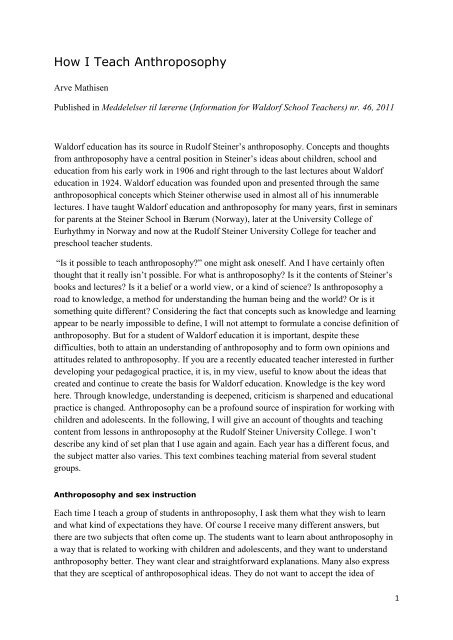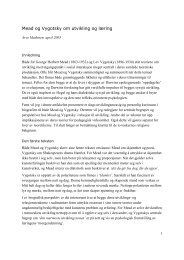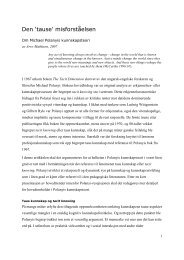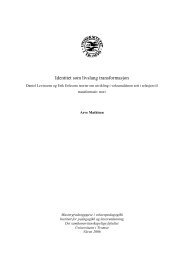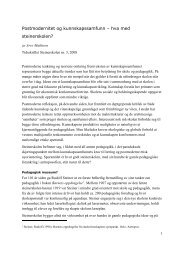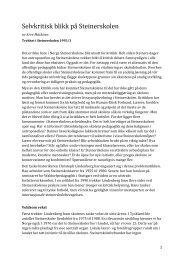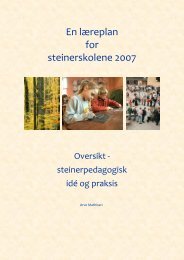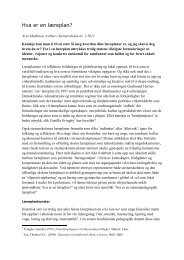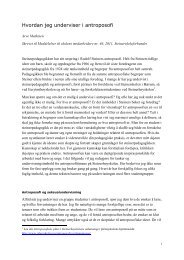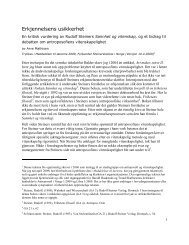How i teach anthropo.. - Arve Mathisen - tekster
How i teach anthropo.. - Arve Mathisen - tekster
How i teach anthropo.. - Arve Mathisen - tekster
You also want an ePaper? Increase the reach of your titles
YUMPU automatically turns print PDFs into web optimized ePapers that Google loves.
<strong>How</strong> I Teach Anthroposophy<br />
<strong>Arve</strong> <strong>Mathisen</strong><br />
Published in Meddelelser til lærerne (Information for Waldorf School Teachers) nr. 46, 2011<br />
Waldorf education has its source in Rudolf Steiner’s <strong>anthropo</strong>sophy. Concepts and thoughts<br />
from <strong>anthropo</strong>sophy have a central position in Steiner’s ideas about children, school and<br />
education from his early work in 1906 and right through to the last lectures about Waldorf<br />
education in 1924. Waldorf education was founded upon and presented through the same<br />
<strong>anthropo</strong>sophical concepts which Steiner otherwise used in almost all of his innumerable<br />
lectures. I have taught Waldorf education and <strong>anthropo</strong>sophy for many years, first in seminars<br />
for parents at the Steiner School in Bærum (Norway), later at the University College of<br />
Eurhythmy in Norway and now at the Rudolf Steiner University College for <strong>teach</strong>er and<br />
preschool <strong>teach</strong>er students.<br />
“Is it possible to <strong>teach</strong> <strong>anthropo</strong>sophy?” one might ask oneself. And I have certainly often<br />
thought that it really isn’t possible. For what is <strong>anthropo</strong>sophy? Is it the contents of Steiner’s<br />
books and lectures? Is it a belief or a world view, or a kind of science? Is <strong>anthropo</strong>sophy a<br />
road to knowledge, a method for understanding the human being and the world? Or is it<br />
something quite different? Considering the fact that concepts such as knowledge and learning<br />
appear to be nearly impossible to define, I will not attempt to formulate a concise definition of<br />
<strong>anthropo</strong>sophy. But for a student of Waldorf education it is important, despite these<br />
difficulties, both to attain an understanding of <strong>anthropo</strong>sophy and to form own opinions and<br />
attitudes related to <strong>anthropo</strong>sophy. If you are a recently educated <strong>teach</strong>er interested in further<br />
developing your pedagogical practice, it is, in my view, useful to know about the ideas that<br />
created and continue to create the basis for Waldorf education. Knowledge is the key word<br />
here. Through knowledge, understanding is deepened, criticism is sharpened and educational<br />
practice is changed. Anthroposophy can be a profound source of inspiration for working with<br />
children and adolescents. In the following, I will give an account of thoughts and <strong>teach</strong>ing<br />
content from lessons in <strong>anthropo</strong>sophy at the Rudolf Steiner University College. I won’t<br />
describe any kind of set plan that I use again and again. Each year has a different focus, and<br />
the subject matter also varies. This text combines <strong>teach</strong>ing material from several student<br />
groups.<br />
Anthroposophy and sex instruction<br />
Each time I <strong>teach</strong> a group of students in <strong>anthropo</strong>sophy, I ask them what they wish to learn<br />
and what kind of expectations they have. Of course I receive many different answers, but<br />
there are two subjects that often come up. The students want to learn about <strong>anthropo</strong>sophy in<br />
a way that is related to working with children and adolescents, and they want to understand<br />
<strong>anthropo</strong>sophy better. They want clear and straightforward explanations. Many also express<br />
that they are sceptical of <strong>anthropo</strong>sophical ideas. They do not want to accept the idea of<br />
1
eincarnation right away and feel alienated from or troubled by concepts like etheric or astral<br />
bodies. For this reason I have chosen to compose the lectures by integrating dialogue about<br />
questions coming from the students and a thorough presentation of selected concepts from<br />
Waldorf education and <strong>anthropo</strong>sophy. Teaching <strong>anthropo</strong>sophy reminds me in many ways of<br />
sex instruction in the lower secondary school years. There is knowledge that can be<br />
communicated, but the value of the <strong>teach</strong>ing depends on all the participants feeling free to<br />
make their own decisions and form their own attitudes. A norm for what <strong>anthropo</strong>sophy can<br />
mean for each individual is just as non-existent as a “normal” sexuality. This has been a prime<br />
concern for me in <strong>teach</strong>ing <strong>anthropo</strong>sophy: how can I contribute to making an open, critical<br />
and inquiring atmosphere which both opens for what is interesting and potentially valuable in<br />
<strong>anthropo</strong>sophy and at the same time nurtures a critical attitude? This is not as simple as it<br />
perhaps sounds. For as soon as I start using <strong>anthropo</strong>sophical concepts, such as etheric body,<br />
for example, and try to present theoretical and practical perspectives on this, a kind of tacitly<br />
understood acceptance of the existence of an etheric body begins hovering in the classroom.<br />
According to the French thinker Michael Foucault’s ideas, it is evident that something as<br />
simple as a conversation and a reflection on a concept at the same time involves an influence<br />
upon those participating in such activities. I discuss this with the students and ask them to be<br />
careful. I want to contribute to an understanding of <strong>anthropo</strong>sophy, not to the spreading of<br />
what I call “<strong>anthropo</strong>sophical conceptual realism”. By this, I mean that such things that<br />
Steiner describes in his lectures are automatically expected to have a parallel in the students’<br />
experience. Ideas should be treated as ideas. It is then up to each individual to decide how the<br />
ideas can relate to his or her own thinking, personal experience and practice. The intention of<br />
the lectures is to work with Steiner’s basic ideas and concepts with the students in an<br />
understandable manner, without the individual student blindly accepting the whole or parts of<br />
Steiner’s world of thought. As I see it, a pronounced critically oriented <strong>teach</strong>ing can penetrate<br />
deeply into <strong>anthropo</strong>sophy’s descriptions of the human being and the cosmos.<br />
Basic ideas?<br />
What is meant by basic <strong>anthropo</strong>sphical ideas? Steiner’s work covers innumerable themes<br />
from religion, art and science. A catchword catalogue published in 1998 filled over 2500<br />
pages 1 . Who can take this in or have the courage to present parts of such an overwhelming<br />
amount of material? Luckily, one might say, Steiner has nevertheless tied most of his<br />
presentations to just a few major concepts. Yes, to put it simply, it can be said that Steiner<br />
expressed large parts of his <strong>anthropo</strong>sophy from two perspectives. The one perspective is<br />
thinking-feeling-willing. Steiner uses this triad of concepts when he presents topics like the<br />
human physical body as well as psychological and spiritual phenomena. At the founding of<br />
the first Waldorf School in 1919, it was just these three − thinking, feeling and willing − that<br />
were the point of departure for Steiner’s presentation of central pedagogical and human<br />
1 Steiner, Rudolf, Mötteli, Emil (1998). Register zur Rudolf Steiners Gesamtausgabe. Dornach: Rudolf Steiners<br />
Verlag.<br />
2
aspects of Waldorf education 2 . The other major complex of concepts in Steiner’s work builds<br />
upon a fourfold division of the phenomena of the world, best known through the so-called<br />
kingdoms of nature and the four elements. Steiner arranged minerals, plants, animals and<br />
mankind in a fourfold concept structure. All of them have a physical body and may be<br />
observed and placed as materially perceptible phenomena. Plants, animals and mankind have<br />
a life in themselves that Steiner characterizes as their etheric body. Animals and the human<br />
being use their senses and ability to move in a conscious and often intelligent way. They<br />
communicate with their environment. According to Steiner, the fundamental abilities of<br />
consciousness such as sensing, moving, wakefulness and communication are the qualities of<br />
an astral body. In addition, the human being has the ability of reflection, self-reflection and<br />
restraint. Steiner associates these qualities with the so-called ego. These four − the physical,<br />
etheric, astral and the ego − are concepts in <strong>anthropo</strong>sophy which very often turn up in<br />
Steiner’s descriptions. In Waldorf education they are key concepts.<br />
Ideas in dialogue<br />
Thus, there exist a triad and a fourfoldedness of basic concepts in <strong>anthropo</strong>sophy, and these<br />
are, in my opinion, very well suited for the <strong>teach</strong>ing of <strong>anthropo</strong>sophy. The students get the<br />
opportunity to accumulate knowledge which is essential for understanding Waldorf education,<br />
and at the same time, they become acquainted with concepts that can be further pursued in<br />
other aspects of Steiner’s works. It’s like learning a language.<br />
One of the really big problems for anyone who wishes to understand <strong>anthropo</strong>sophy is that it<br />
has partly existed in a kind of vacuum regarding communication and sharing of knowledge.<br />
Steiner was set on emphasizing what was unique about his <strong>anthropo</strong>sophical project and<br />
marked a critical distance to many, if not most, of his contemporaries. Waldorf education, for<br />
example, has much in common with reform education of that day, but Steiner rarely pointed<br />
out similarities or relationships in this instance. On the contrary, he propounded critical<br />
comments on contemporary reform educational experiments. For a current understanding of<br />
<strong>anthropo</strong>sophy, it is my opinion that a kind of restoration process must take place. It is not<br />
only a question of building bridges here. Perhaps the image of ‘opening the dams’ could be a<br />
better metaphor. Wherever I get deeply absorbed in philosophy, education, sociology,<br />
psychology or the theory of science, I find themes that touch upon and ‘converse’ with<br />
<strong>anthropo</strong>sophy. In the same way that it is difficult to really know one’s own country before<br />
one has been abroad, it is my opinion that <strong>anthropo</strong>sophy is very hard to understand or work<br />
on without dealing with it comparatively. That is why I have generally related the study of<br />
Steiner’s basic concepts to other thinkers who have taken up similar themes.<br />
The idea of understanding education based on thinking, feeling and willing is by no means<br />
new with Steiner. We find germs to such a pedagogical idea in Plato’s work. Comenius, who<br />
is often characterized as the ‘father’ of modern education, emphasizes that learning must take<br />
2 This is especially expressed in the lectures published in the book: The Study of Man. This can be<br />
called a classic in the Waldorf education world. At the same time the book, through its complexity<br />
and enigmatic contents can also be characterized as being on the border of the understandable.<br />
3
place in all these areas. Most famous is perhaps the Swiss educational pioneer, Johan Heinrich<br />
Pestalozzi, who built his educational practice on a balanced engagement of ’head’, ’heart’ and<br />
‘hand’. John Dewey, still of current interest, has reflected upon this, and today there are<br />
countless pedagogical theories that emphasize emotional learning and different forms of<br />
learning by doing in addition to cognitive or intellectual schooling. 3 There is something<br />
intuitively and almost pedagogically self-evident about theoretical learning belonging to<br />
emotional involvement and happening when pupils gather concrete experience. A theory of<br />
education based on this triad of concepts invites children and adolescents to learn and develop<br />
in a complete way. Thinking, feeling and willing refer to activities. The verbs ‘to think’, ‘to<br />
feel’ and ‘to act’ say something about what children and adolescents do in kindergarten and<br />
school. When these activities are put into an educational and developmental perspective,<br />
Waldorf educational reflection and developmental work is underway. In Waldorf<br />
kindergartens and Waldorf schools, thinking and the formation of concepts builds upon<br />
emotional experiences, which in turn build upon the most basic ‘learning by doing’. The<br />
integration of thinking, feeling and willing means that the establishment of identity and ethics<br />
connects with learning. The pupil is given the opportunity to be emotionally present and<br />
actively prepared for his or her thoughts. Based upon the intuitively pedagogical side of the<br />
ideas of thinking, feeling and willing and on how other pedagogues have worked on these<br />
ideas, <strong>anthropo</strong>sophy’s distinctive character and its ‘normality’ can come into view. In many<br />
ways it is alluring how this triad of concepts in Waldorf education appears popular and<br />
understandable. On the one hand, an aspect of <strong>anthropo</strong>sophy appears as an almost<br />
mainstream view on education. On the other hand, some of Steiner’s reflections on thinking,<br />
feeling and willing lead way, way out into what are, for most people, unknown waters. Those<br />
who have read, or have tried to read, The Study of Man know what I am talking about. After a<br />
comparative study of the idea of thinking, feeling and willing, selected aspects of this book<br />
may be introduced for discussion and reflection. In the article Pedagogical Aspects of<br />
Slowness. Aristotelian and Platonic Elements within Knowledge of Man 4 , I have discussed a<br />
few of Steiner’s descriptions of thinking, feeling and willing, also comparatively. In addition<br />
to reading excerpts from Steiner’s original texts, I have let the students read this article.<br />
Sometimes, the students have summarized and given introductions for discussion, while other<br />
times, I have done so.<br />
Complex and fourfold<br />
Steiner’s descriptions of the fourfoldedness of nature and the human being are experienced by<br />
many students as being far less intuitive than the ideas of thinking, feeling and willing. The<br />
mere words ‘ether’ and ‘astral’ cause many to shake their heads. In the same way, the old idea<br />
that nature is built up hierarchically with minerals at the bottom and the human being on the<br />
3 A current book that argues in favour of the interplay of thinking, feeling and doing is: Ellis, Ralph D., Newton,<br />
Natika (2010): <strong>How</strong> the mind uses the brain: to move the body and image the universe. Chicago: Open Court.<br />
Both authors are philosophers, and the book emphasizes a kind of basic research that in many ways converses<br />
well with Steiner’s understanding of the human being and education.<br />
4 The article can be downloaded from: www.arvema.com/<strong>tekster</strong>/Slowness_LivingEducation3_2007.pdf<br />
4
top, will be unacceptable. Several students will point out that animals communicate and have<br />
their own ways of thinking.<br />
During the lectures, we take our time studying and reflecting upon the idea of the<br />
fourfoldedness of the human being and world. This is a very old idea that we can trace from<br />
early Indian Upanishads via Aristotle and Plato in Ancient Greece and into our own time. The<br />
idea flourished in the Middle Ages and the Renaissance, and is still kept alive by certain<br />
thinkers, also outside <strong>anthropo</strong>sophy. I have compiled a compendium documenting this<br />
idea’s many historical expressions through short excerpts of original texts 5 .<br />
A print from the book Liber de Intellectu (Paris, 1510) by the French author, philosopher and theologian Charles<br />
de Bouvelles (1471-1553). The picture illustrates the division of the kingdoms of nature into four levels: est (to<br />
be, exist), vivit (to live), sentit (to sense, feel, experience) and intelligit (understand). On the left hand side of the<br />
picture, levels from mineral to the human being can be seen, while the right hand side shows how the human<br />
being sinks down if he succumbs to deadly sins such as lust (luxuria), gluttony (gula) or sloth (acedia).<br />
Two interesting current thinkers who have concerned themselves with the idea of dividing<br />
reality into different levels are Michael Polanyi 6 and Norbert Wiley 7 . Polanyi argues for the<br />
5 If you are interested, you can download the compendium here:<br />
http://dl.dropbox.com/u/383934/Kompendium_de_fire_2010.pdf<br />
6 Polanyi, Michael (2009). The tacit dimension. Chicago: The University of Chicago Press.<br />
5
existence of a creative tension between various levels both in the human constitution and in<br />
the world, as, for example, between biology and the mind. Instead of claiming that everything<br />
boils down to material processes, or that everything is biology, that everything is basically<br />
psychology, or everything is language, etc., these two authors point out how a composite<br />
understanding of the human being has many advantages. Like Steiner, they see a value in<br />
approaching the human being as a complex material, biological, mental, lingual-reflectivesocial<br />
being. There are plenty of arguments against such a fourfoldedness. While thinkers<br />
who partially share Steiner’s ideas are given space, it is of course necessary to present<br />
conflicting or alternative thoughts.<br />
The idea of a hierarchical division of nature from imperfect minerals, plants and animals to<br />
the human being towering freely at the top of the creation has been associated with value<br />
ranking and, later, discriminating ideologies of various kinds. Quite a few authors have<br />
discussed the problems of such thoughts, and especially in the last few years, there has been a<br />
great interest in the characteristics of animals 8 . Steiner often expresses himself along the same<br />
lines as classic value ranking and hierarchical ideas when he describes the relationship<br />
between animals and mankind, but there are also important exceptions to this in Steiner’s<br />
work. I have chosen to emphasize some of these in my <strong>teach</strong>ing. The printed picture from the<br />
1500’s shows the human being in possession of all four qualities or levels, while animals and<br />
plants have fewer. In several accounts, Steiner reacts to such a lacking description of<br />
minerals, plants and animals. He claims that everything existing on earth has all four qualities,<br />
they are just put together in different ways: “This fourness exists in all beings on earth” 9 . In<br />
this way, a mutual equality between the various ‘citizens’ of the planet Earth is emphasized.<br />
Another example of a way of thinking that represents both a clear contradiction and an<br />
interesting thought development in relation to Steiner is Michael Foucault’s work. While<br />
Steiner was to a great extent preoccupied with the ‘ego’ as an expression for the ability of<br />
speaking, thinking and free action, Foucault researched the various mechanisms and structures<br />
of power that influence the human subject, often in such subtle ways that the person believes<br />
himself to be acting of his own will and freely. Foucault has, for example, referred to how<br />
knowledge and language discipline and structure people. Interestingly enough, it turns out that<br />
many of Steiner’s statements about the ’ego’ are far from being in contradiction with<br />
Foucault’s analyses here. In Steiner’s concept of the ego there lie qualities of both giving and<br />
7 Wiley, Norbert (1994). The semiotic self. Chicago: University of Chicago Press. Se kapittel 6, 7 og 8.<br />
8 Calarco, Matthew (2008). Zoographies: the question of the animal from Heidegger to Derrida. New York:<br />
Columbia University Press.<br />
Derrida, Jacques, Mallet, Marie-Louise (2008). The animal that therefore I am. New York: Fordham University<br />
Press.<br />
Lurz, Robert W. (2009). The Philosophy of animal minds. Cambridge: Cambridge University Press.<br />
Gould, Stephen Jay (1977). Ontogeny and phylogeny. Cambridge, Mass.: Belknap Press of Harvard University<br />
Press.<br />
9 Steiner, Rudolf (2001). Bewusstsein - Leben - Form (GA 89). Dornach: Rudolf Steiner Verlag, s. 293.<br />
6
eceiving, the ability to both influence the environment and be influenced by the environment.<br />
At the end of his life, when Foucault was preoccupied with the self’s “concern for itself”<br />
through self-developing exercises, his thinking coincided to a large degree with Steiner’s<br />
thoughts on ethics and human development.<br />
Etheric body – visible and invisible<br />
Now, it can appear that the <strong>teach</strong>ing of <strong>anthropo</strong>sophy to a great extent is philosophically<br />
orientated and has less focus on education and practical career relevance. <strong>How</strong>ever, I try to<br />
create a balance here. As an example of how pedagogical reflection and conversations on the<br />
concrete <strong>teach</strong>ing of children also have their place, I will finish off by bringing up some<br />
aspects of how we have approached Steiner’s concept of the etheric body. Having looked at a<br />
couple of Steiner’s original texts, it becomes clear that his understanding of the living (the<br />
etheric) has to do with processes in time that express themselves rhythmically. According to<br />
Steiner, the etheric body is the carrier of “habit, character, conscience and memory” 10 . These<br />
catchwords alone open for a cascade of themes of concrete pedagogical relevance. For<br />
example, how can the school contribute to the development of good habits? <strong>How</strong> can <strong>teach</strong>ing<br />
be done in a life-promoting and rhythmic way? The close connection between etheric and<br />
artistic activity becomes a topic. Also, Steiner’s thoughts on the seven life processes are<br />
appropriate as a starting point for conversations on how a life-promoting, varied and<br />
‘nourishing’ education can be formed. In addition, we have worked comparatively. It turns<br />
out that habits have been one of the most discussed pedagogical topics throughout all eras. On<br />
the one hand, we have Plato, Augustine, Luther and Bourdieu, just to mention a few, who<br />
have seen habits as an obstacle, a reduction of the human being’s freedom, and even as the<br />
location of original sin, according to Luther. On the other hand, pedagogically relevant<br />
thinkers such as Aristotle, Dewey and Deleuze have shown how habits are central to the<br />
human being’s development. Often, the formation of good habits is related to educational<br />
ideals regarding the development of ethical and self-determining individuals 11 . In this context<br />
I let the students read excerpts of an article I have written, where the practical pedagogical<br />
relevance of habits is discussed in relation to art and artistic <strong>teach</strong>ing. Here, ideas from Steiner<br />
meet similar thoughts of Dewey and Bourdieu.<br />
I don’t know how many lectures we use to dwell on the topic of life (the etheric) in the<br />
<strong>teach</strong>ing of <strong>anthropo</strong>sophy. By looking at life in relation to experience and pedagogical<br />
thinking in general, in addition to the presentation of Steiner’s thoughts, these lectures invite<br />
each student to work out his or her own understanding and assessment of a concept like<br />
etheric body. For while the etheric is both invisible and, to a large extent, an unrecognized<br />
concept, habit, character, memory, art and rhythm have clear connections with both<br />
completely visible everyday school life and with pedagogical thinking beyond Waldorf<br />
education. In addition, a concept like etheric body can lead to both feelings and reflections<br />
10 Steiner, Rudolf (1983). Die Erkenntnis des Übersinnlichen in unserer Zeit und deren Bedeutung für das<br />
heutige Leben (GA 55). Dornach: Rudolf Steiner Verlag, s. 123.<br />
11 For an inspiring introduction to the history of the concept of habit, see: Carlisle, Clare (2006). Creatures of<br />
habit: The problem and the practice of liberation. Continental Philosophy Review 38, 19-39.<br />
7
that touch on life’s greater questions and secrets. It makes way for marvelling at the entire<br />
world, for new thoughts about one’s own life and for new perspectives and possibilities in<br />
working with children and adolescents.<br />
For me, <strong>anthropo</strong>sophy can be like a garden, even a ‘secret garden’, where it is not first of all<br />
a question of what grows there, but where the value lies in all that can happen with whoever<br />
works and lives in the garden. The garden is a meeting place where diversity and differences<br />
not only are tolerated, but make up the basis of life. From year to year, other and perhaps new<br />
plants grow in a garden, and both flowers and weeds belong there. The garden as a metaphor<br />
fits well with the above reflections. The garden symbolizes a living world, a partly visible and<br />
partly invisible microcosm. In medieval literature, the garden was frequently used as an image<br />
for a ’place’ of initiation – and at the same time, the garden is a piece of nature where the<br />
dandelion stands smiling strong and yellow.<br />
Translated in cooperation with the author by Ann Stackpole<br />
8


